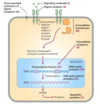Cancer Flashcards
(47 cards)
fraction americans that develop cancer and percent that die of cancer
1/3 of americans develop cancer
22% of americans die of cancer
carcinoma
from epithelial cells (ducts, body cavity lining, visceral organ lining)
sarcoma
from connective tissue
lymphoma
blood born cancers
most cancers are ____ (carcinoma, sarcoma, lymphoma)
carcinoma
neoplasm
tumor
proliferative growth that leads to a mass of cells
where do tumors typically originate?
typically originate in stem cells; rarely differentiated cells
characteristics of benign growth
- non – invasive
- cell-cell interactions maintained
- confined to original location
- does not reach basal lamella
- can be invasive if bulky
characteristics of cancerous growth
- “malignant” = threatening
- invasive and metastatic
- cell-cell interaction affected
- may de-differentiate
- may evade immune system
- cancer cells often exhibit altered surface molecules that are non-self
Hanahan-Weinberg – The Defining Characteristics of Cancer
- self-suficiency in growth signals
- insensitivity to growth-inhibiting signals
- evasion of apoptosis
- limitless replicative potential
- sustained angiogenesis
- tissue invasion and metastasis
- Warburg metabolism (change in glucose metabolism)
- evasion of immune system
Warburg metabolism
changes in glucose metabolism to accommodate cancer cell’s obsession with glucose
- cancer cells and proliferating cells convert most glucose to lactate regardless of whether oxygen is present or not - -aerobic glycolysis
cancer characteristic: Insensitivity of Growth-Inhibiting Signals
- cancer cells ignore contact inhibition
- cancer cells will growth past the point of confluent growth; will continue growing even if bottom of dish has a full layer of growth
cancer characteristic: Evasion of Apoptosis (#3)
- cancer cells avoid undergoing apoptosis and are able to circumvent the apoptotic process
Limitless Replicative Potential (#4)
- cancer cells do not demonstrate a hayflick limit
- most normal cells have a limited potential to divide; cancer cells are immortal
cancer characteristic: Sustained Angiogenesis (#5)
- cancer cells induce angiogenesis in order to keep tumor cells from becoming hypoxic
- all cells in the body are within a millimeter of a capillary; if cells in a tumor get more than a few millimeters from a capillary they will become hypoxic
consequences of induced angiogenesis
- nutrients and oxygen are supplied to the tumor
- new blood vessels provide as easy way ou
Angiogenesis stimulated by:
- endothelial cell development stimulated by: VEGF and FGF
VEGF
VEGF: vascular endothelial growth factor
- ligand for VEGF-receptor (tyrosine kinase)
- produced by tumor cells and tumor-associated macrophages
- importance of VEGF tested by transporting tumor of one animal to another to check for growth of vasculature around tumor
cancer characteristics: Tissue Invasion and Metastasis (#6)
- cancer cells are invasive
- able to breach borders
- seldom does a primary tumor kill a patient – it’s almost always a secondary tumor
Seven Types of Proteins That Participate in Controlling Cell Growth and Proliferation
- extracellular signaling molecules
- signal receptors
- signal transduction proteins
- transcription factors
- cell-cycle-control proteins
- function to restrain cell proliferation - DNA-repair proteins
- apoptotic proteins

tumor suppressor genes encode for:
cell-cycle-control proteins and DNA repair proteins
mutations in two broad classes of genes have been implicated in the onset of cancer:
proto-oncogenes and tumor-suppressor genes
proto-oncogenes
promote cell growth; mutations change them into oncogenes whose products are excessively active in growth promotion
tumor suppressor genes
restrain growth; mutations that inactivate them allow inappropriate cell division
caretaker genes
protect the integrity of the genome; when they are inactivated, cells acquire additional mutations at an increased rate





